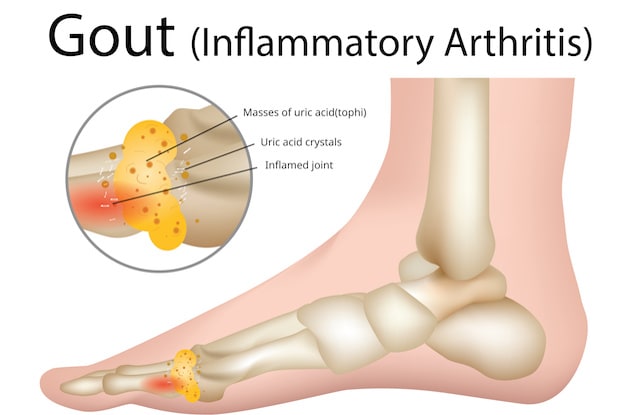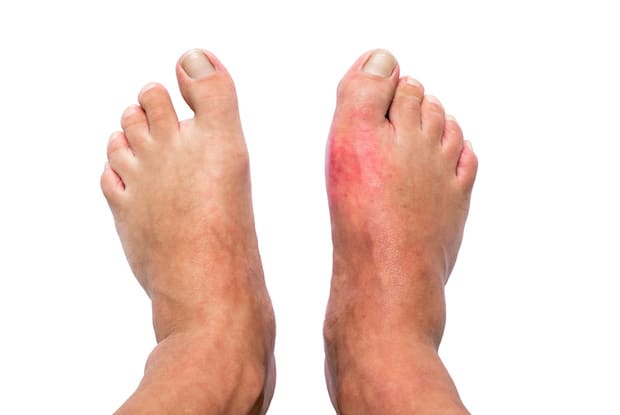Table of Contents
b. How does Uric Acid Cause Gout?
b. Gout Prevention Medications
What is Gout?
Gout is a form of arthritis that causes sudden, painful sensations in the affected joints. It is a common condition and affects more than eight million people in the United States. [1] Gout can have a severe effect on people’s quality of life, causing pain and disrupting their sleep and mobility.
Gout is an inflammatory condition that causes severe pain and swelling in a specific joint. In around half of gout cases, the gout is located in the big toe of either foot. However, gout is also commonly found in other toes, fingers, elbows, knees, and can affect any joint. [2]
a. Symptoms of Gout
Gout does not cause constant pain throughout your life. Instead, it is a condition that causes occasional flares. These flares cause pain and swelling. Typically, a flare-up of gout occurs overnight and then lasts for several days or weeks. Usually, these flares are followed by a long period of remission that can last for months or years without any other symptoms. [3] However, some unfortunate patients may have recurrent gout multiple times a year.
Swelling and pain in the joint is the most obvious sign of gout. However, this alone is not enough to diagnose gout, as conditions exist with similar symptoms. The pain is most severe for the first four to 12 hours following an attack, but pain may remain for days or weeks. The affected joint may turn red or purple and become tender and warm to the touch. It can be incredibly painful to put weight on a gout-affected knee, ankle, or foot and may impair mobility.

Keep reading to learn more about gout, including the causes, symptoms, and how it can be treated with medications such as Colcrys (colchicine), Uloric (febuxostat), and Zyloprim (allopurinol).
What Causes Gout?
a. What is Uric Acid?
Uric acid is a natural substance that is found in the human body. Uric acid is produced naturally by the body when it breaks down purines. Purines are another natural body substance, although they are also found in certain foods and drinks. [4] Generally, uric acid is dissolved in the blood before the kidneys remove it from the body through urine.
b. How does Uric Acid Cause Gout?
When the body produces excess uric acid or removes too little of the chemical, then a build-up may occur. When uric acid builds up, it can cause needle-like urate crystals to form in a joint. The body’s immune system responds to these sharp crystals by inflaming the area. Gout typically occurs overnight as the body’s core temperature lowers, which allows the urate crystals to form. The condition is more common in fingers and toes, as these areas of the body tend to be colder than other body parts. [5]
Risk Factors for Gout
Gout can affect anybody. However, there are several factors that can increase the risk of developing the condition.
a. Genetics
Gout is a partially genetic condition. While there is no specific gene for developing gout, certain genes involve the transportation and removal of uric acid and contribute to the likelihood of developing gout. People that have a close family relative with the condition have a higher risk of developing gout themselves. [6]

b. Age and Gender
Men naturally have higher levels of uric acid in their bodies. Because of this, men are four times more likely to develop this condition than women. [7] In men, the condition typically occurs between the ages of 30 and 50, while for women, it usually occurs post-menopause. [5]
c. Diet
Diet is a well-known risk factor for gout. While purines are naturally found in the body, they also enter the body through the foods and beverages we consume. Eating a diet that is heavy in purines increases the risk of developing gout because more uric acid is produced in order to break down the extra purines. All food and drinks contain purines.
However, anything that has a purine content higher than 200mg per 100g of food is considered high in purines. People with gout should avoid or limit their consumption of these foods. Alcohol, red meat, seafood, and sugary foods are all particularly high in purines.
d. Body Weight
Bodyweight is another important factor for developing gout. Studies show that people who are overweight or obese develop gout on average ten years before people that are a healthy weight. [8] This is because people that are overweight have less efficient kidneys and cannot remove as much uric acid when urinating.
Body fat storage also plays a major part in the development of gout. People who have more ‘belly fat’ are more at risk of gout. This is because more inflammatory chemicals are produced by the stomach than other areas of fat. [8]
e. Medical History
People that have gout are also more likely to have other chronic medical conditions. Over half of gout patients suffer from five or more chronic conditions. This commonly includes high blood pressure, heart disease, kidney disease, diabetes, and metabolic syndrome. [5] [9]
How to Treat Gout
a. Lifestyle Changes
Mild cases of gout often do not require medication or treatment. Instead, managing risk factors can prevent future gout attacks. For people that have moderate or severe gout, these lifestyle changes are unlikely to eliminate gout flare-ups but can reduce the severity of symptoms.
Lifestyle changes like eliminating high purine goods are recommended for people with gout. You can speak to your doctor or a nutritionist to help find healthier alternatives to alcohol, red meat, and sugars. For patients that are overweight, it is also important to attempt to lose weight. Losing weight will help increase the efficiency of the kidneys, reducing the build-up of uric acid.

b. Gout Prevention Medications
Medications such as Uloric (febuxostat) and Zyloprim (allopurinol) can be prescribed to reduce the likelihood and severity of future gout attacks. Doctors may prescribe these medications for patients that have recurrent gout or who have a risk of developing complications.
c. Pain Relief Medications
Colcrys (colchicine) is commonly prescribed to treat pain caused by gout. Colcrys is not a generic pain killer and should only be used to treat gout. It is an anti-inflammatory medication that helps reduce the build-up of uric acid. [10]
Doctors may also prescribe the corticosteroid prednisone. This medication works as both an anti-inflammatory and immunosuppressant drug.
The content in this article is intended for informational purposes only. This website does not provide medical advice. In all circumstances, you should always seek the advice of your physician and/or other qualified health professionals(s) for drug, medical condition, or treatment advice. The content provided on this website is not a substitute for professional medical advice, diagnosis or treatment.
